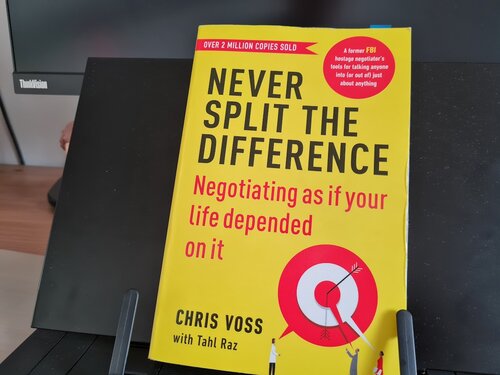Manager's Summary of the Book 'Never Split The Difference'
Posted on Jan 2, 2023. Updated on Feb 6, 2023
I enjoyed reading the classic “Never Split The Difference” by Chris Voss. It contains many tools for negotiations but also for building relationships, trust and dealing with conflicts and emotions. That’s why it is very valuable for engineering managers. In this post, I summarize my key takeaways and lessons learned.

Introduction
Although the book revolves around negotiations, you can use the covered tools in more situations than these. Many of them are crucial for engineering managers. I see three use cases:
- Building Relationships and Trust
- De-escalate a Conflict and Deal with Others' Emotions
- Negotiations
🎯 Building Relationships and Trust
The following tools are helpful in every setup where you have to quickly establish a relationship and trust (with an unknown person).
🛠️ Mirroring
Repeat the last three words (or the critical ones) of what someone has just said.
“I used to play video games” - “video games?”
This encourages your counterpart to keep talking to get more information, makes the other feel heard, or drains the emotions from the dialog.
🛠️ Labeling
Label your counterpart’s (negative) feelings (like anger or sadness) to diffuse their power. That is useful to deal with their emotions.
- “It seems like you are upset.”
- “It seems like you feel like …”,
- “It seems like you are really passionate about …”
It helps de-escalate angry confrontations because it makes the person acknowledge their feelings rather than continue to act out. Once they’ve been labeled and brought into the open, the negative reactions in your counterpart will begin to soften.
🛠️ Summaries
Summaries = Paraphrasing + Labeling.
Repeat the world according to your counterpart in your own words. Try to trigger a “that’s right” from your counterpart.
“So what you’re saying is…”
Convince someone that you genuinely understand their dreams and feelings to soften your counterpart and lay the foundation for a breakthrough.
🛠️ Avoiding “Why”
Avoid asking questions with “Why”. They often feel like an accusation and aggressive. Instead, use “How” and “What” questions (see calibrated questions below).
- “How come?”
- “What are we trying to accomplish?”
- “What’s the biggest challenge you face?”
🎯 De-escalate a Conflict and Deal with Others' Emotions
We can reuse all tools we just learned.
- 🛠️ Use mirroring and summaries to make others feel understood and drain emotions from the dialog.
- 🛠️ Focus on labeling to defuse the other’s emotions.
🛠️ Accusation Audit
List the worst things the other could say about you and say them before the other person can. Prevent negative dynamics and disarm them.
“You may feel like we have treated you unfairly, and …”
🎯 Negotiations
🛠️ First, establish a relationship and soften the counterpart using the above tools.
🛠️ Calibrated Questions
Calibrated questions are starting with “How” and “What”. They point your counterpart toward solving your problem. They allow you so say no without saying “No”.
- “How am I supposed to do that?”
- “How can we solve this problem?”
- “How would you like me to proceed?”
🛠️ Extreme Anchors
In price/salary negotiations, start with an extreme anchor. Your counterpart unconsciously adjusts their expectations in the direction of the anchor. Some might directly go to their limit.
🛠️ Use Ranges
Instead of a single number, go with a range from Min to Max (“80k - 110k”).
- For Min, use the number you want.
- For Max, use an extreme anchor.
Next to the Max (the extreme anchor), the Min looks cheap. Chances are you end up with the number you wanted or even better.
🛠️ Use Odd Numbers
Odd numbers (like 37.234 €) feel like a number you come to due to a thoughtful calculation.
🛠️ Endure Silence
Bite your tongue a) while listening and mirroring, b) after making an offer, c) after asking a calibrated question, d) when attacked in a negotiation to avoid angry emotional reactions.
Silence often means the other is thinking, e.g., about a counteroffer for you or to come up with a solution for your problem.
🛠️ Ackerman Bargaining
The Ackerman Bargaining is guide for setting and making offers in negotiations. It incorporates tools we have already learned, like extreme anchors, calibrated questions, and well-defined offers. Steps:
- Define your target price. e.g. 100k.
- Start with 65 % of your target price. That is the extreme anchor. e.g. 65k.
- Go stepwise down to 85%, 95%, and 100%
- After every bid, use a lot of empathy and calibrated questions to say no (without saying “no”) and make your counterpart bid against themselves. “That is very generous of you, but I can’t. I’m sorry. How am I supposed to accept it when…?”
- Close with a non-round number and add a nonmonetary item to show you are at your limits. This will make your counterpart believe that they have squeezed out everything possible. But you’re getting to the number you want.
I created a spreadsheet helping me calculate the bids and to prepare good calibrated questions and phrases to reply to my counterpart’s bids.

Further Reading
- Check out Chris Voss' book “Never Split The Difference” and his YouTube channel.